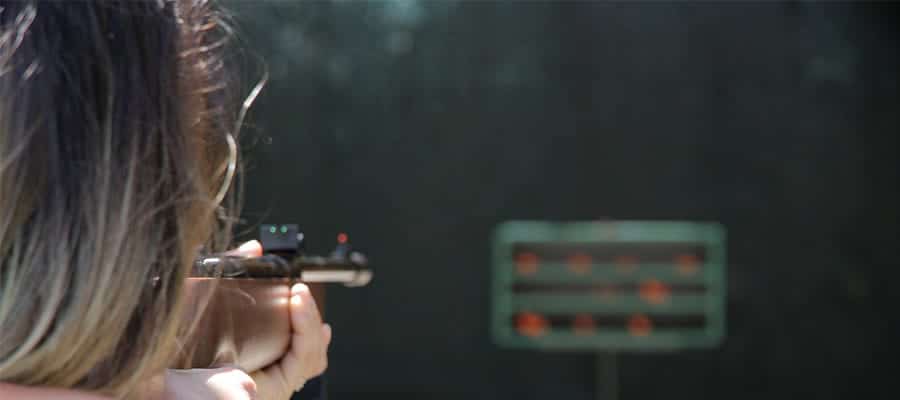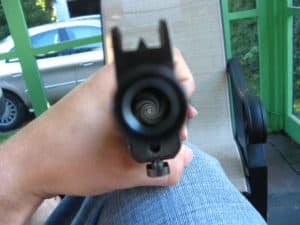
When you feel like you are doing everything right, but your accuracy is anything but consistent it can be very frustrating. Every shooter wants a tight shot group. It’s fun to see when you are plinking, and it translates into more success when you are hunting.
Is it you, or is it your gun? Without watching you shoot I can tell you it’s a little bit of both. Lucky for you there are some simple solutions I can give you right now that will immediately start to improve your shot group. I think it’s important to address your gun first. Let’s make sure it’s in the best shape it can be to provide the most consistent results. Once your gun is set up we can begin to focus on you. By improving your gun then improving your technique you are more than doubling your chances for success.
Improve Your Airgun
1 – Clean Your Barrel
Airguns don’t need to be cleaned as often as firearms, but they still need to be cleaned. If your gun was accurate but isn’t anymore it could be in need of some cleaning. Excessively fouled barrels can cause very inconsistent results. Sometimes you need to think about cleaning your barrel are:
- When it’s brand new – Lots of barrels come with preservatives and other conditioning to ensure they get to the customer in good shape. This can really affect your accuracy so clean your gun when you first get it.
- When it has been left for a long time – Even when you can’t see rust there could be some deeper in the barrel. It’s a good practice to do a cleaning when you get an airgun out of storage.
- When your accuracy goes from consistent to inconsistent – Your gun might have been fouled in a way that is causing your problems. Cleaning is easy and should be one of the first things you do to improve your accuracy.
2 – Foul Your Barrel
Didn’t I just tell you to clean your barrel? After your barrel has been cleaned you will probably experience a short period of inaccuracy. I put this in as a step because you’ll find shooters out there telling you cleaning your barrel leads to problems. This is only a temporary condition. As long as you expect it, and throw a few rounds downrange you’ll find you come back to consistent in very little time.
3 – Break Your Gun In
This is for those of you who bought a gun and are disappointed in it right from the start. All Airguns have a breaking in period, but springers need one most of all. Due to the characteristics of springs, a springer could take anywhere from 1000 to 5000 rounds to really settle in. Springs have memories, and the tension will weaken some.
People have used this initial change in tension to state a springer will fail in a few years. This is false. Once your spring hits a certain point you will have many years, and many more thousands of rounds at optimal to look forward to.
4 – Use the Right Pellets
One of the most important decisions you can make for your accuracy is which pellets you will use. I don’t just mean picking the right pellet type for the job. Airguns are notoriously picky with pellet choice. You’ll have to test different pellet brands to see how they perform. Different brands and different price points allow for a larger variation in the pellets. Some guns handle this differently. I’ve seen some airguns use cheap pellets very accurately and expensive ones poorly and vice versa.
It’s like pellets are food and your airgun is your child. Once you figure out what kind of pellet your airgun wants, stick with it and you’ll have great success.

5 – Don’t Over Lubricate
A very common error among beginners is over-lubricating your barrel. We want our gun to perform the best, and to last forever so we overdo it. Too much oil can lead to dieseling some of the time.
Dieseling is when the oil ignites from the pressure behind the pellet causing a change in the force propelling the pellet. This won’t happen consistently every time and could cause your accuracy to suffer.
6 – Fix Loose Stock Screws
Loose stock screws are far too common, particularly in spring-piston airguns. If these screws are loose your gun will shift differently every time you fire it. The biggest part for me is that you won’t necessarily be able to predict how it will fire. For me, it’s always about consistency. Using good screws you can tighten these down. If they are continuing to come loose, take them out, clean them up and use a very small amount of Loctite to seal get a really good grip.
7 – Tighten All Remaining Screws
Stock screws are so important and common I feel mentioning them separately is necessary, but they aren’t the only screws on your airgun. The next step is to just inspect your airgun and ensure everything is tight. Don’t go stripping screws trying to overtighten. Just make sure everything is actually snug. Again, make sure you use good screwdrivers designed for use with guns. Screwdriver sets have different tolerances, and you need really good ones to avoid wrecking the screws on your gun.
8 – Mount Scope Properly
Duh… Right? Well, there is a bit more to it than people think. It’s not just making sure your mount is on correctly, but also that you are using an airgun specific mount. Airguns, particularly springers, have a backward recoil like firearms, and a forward snap, unlike firearms.
If you use the wrong mount it will contribute to mount creep. Your scope will start moving forward and will progressively become more and more inaccurate.
9 – Mount the Proper Scope
What do I mean when I say the proper scope? I want you to mount an airgun specific scope. But, manufacturers make some amazing scopes for regular rifles that will fit perfectly on my air rifle, can’t I use one? No. Regular scopes aren’t designed with the same tolerances in mind.
First, airguns have the backward and forward recoil to deal with. Firearm scopes are designed to handle very strong backward recoil but do not have the engineering to deal with the forward recoil because they just don’t need it. Airguns need that extra little bit of engineering to protect the lenses, etc.
Second, most scopes are designed to be most effective outside of an airguns maximum range. While they will be accurate, the way the lenses are set up they reach a maximum efficiency at a further, more common distance of somewhere around 100 yards. Airguns need to be able to be adjusted to handle much shorter ranges. More around the 60 and less yard range.

10 – Is Your Barrel Locking Correctly with Proper Tension
This is specifically for break barrels. There is a pivot pin that is absolutely… pivotal… to your success. (Yes I’m proud of my dad jokes). If there is a problem around this pivot pin your barrel may not lock properly and it will be misaligned. Worse, it will lock in a slightly different position each time.
Luckily, as this is such an important issue airgun manufacturers have done us some favors. First, they’ve engineered this portion of your airgun to have as little negative wear as possible. Second, most quality break barrels should give you the ability to adjust the tension. This is so you can take up some of the slack that has entered into the equation over time.
DO NOT OVERTIGHTEN. Over tightening will cause inaccuracy too. Too tight and too loose will both provide inconsistent grouping.
11 – Check Your Crown for Defects
The crown of your airgun is the last part of the barrel that has an effect on the pellet. If it’s been gouged, scraped, scratched or otherwise abused you may have a problem on your hands. Interestingly, there are a number of experiments and anecdotes that say a bad crown won’t affect your accuracy. There are an equal number of anecdotes the other way.
The truth is somewhere in the middle. A bad crown doesn’t always make you inaccurate, but it can. If you’ve done everything else on this list and you are still having problems you might want to check your crown. Unfortunately, I don’t have experience fixing a crown and recommend a gunsmith do it. They have the proper tools and knowledge required to do the job right.
12 – Make Sure Rifling Isn’t Bad
Shine a light down the barrel and take a look at your rifling. Make sure your cleaning or other activities haven’t messed up your rifling. This is last on my list for gun improvements because you again need a professional to fix this issue, and it’s hard to know if there are problems.
You are looking for any gouges or marks along the rifling, as well as if it is too shallow in some areas compared to others.

Improve Your Technique
13 – Use the Important Artillery Hold
Oh man, if you look into airguns at all you will come across discussions about the artillery hold. They are right, you need to master this hold for airguns, particularly springers. If you go on a forum to ask for help with your accuracy you will get told you need to work on your artillery hold, even if you state you’re good at it.
I’m not going to go into too much detail because other people have already made amazing resources covering the artillery hold in detail. The basics are that you do not rest your air rifle on a hard surface, and you do not hold it so tight it cannot move. Pellets take longer to leave the barrel of an airgun than a bullet does from a firearm. A bullet should leave before recoil starts, a pellet does not. So the artillery hold allows your gun to re-lock on your target. Holding on too tightly exaggerates the recoil.
14 – Maintain Sight Picture Longer
In conjunction with the artillery hold make sure you maintain your sight picture longer. I think of this as follow through like in golf. You look where you want your pellet to go, and you keep your sight picture on target. This will make sure you are still on target when the pellet leaves the barrel.
Yes, we are talking infinitesimal time frames, but if you’ve ever been in sports before you understand how important follow through is. The principles hold true here as well.
15 – Always Use the Same Contact Points
Always use the same contact points for your airgun. Placing your hand in the same spot, in the same way, and seating the airgun in the same spot will dramatically change your results. If you do not the movement of the airgun during the artillery hold will not be as predictable and you will lose your accuracy.
This is something you can work on over time. It’s a bit tedious at first, but once you get comfortable with your positioning you’ll find that you naturally come to the same position very easily.
16 – Make Sure You Zero Correctly
I know this is a bit trite and obvious, but people really do mess this up badly. When you are zeroing the entire goal is to have a tight group. Aim at the exact same spot with every shot. Do not try to adjust your aim point to become more accurate. The point is to dial in your scope or sights so that your group tightens up.
Lots of people have trouble maintaining the right sight picture when zeroing. They want to hit the target so they’ll offset their sight picture about as much as the previous shot is off. That’s not what zeroing is about! Get this right and you’ll be very happy with your results.
Practice Good Fundamentals
OK, the rest you can do for yourself is not specific to airguns and there is a lot of information out there about it, so I’ll cover a couple of things, but I am not going to go in depth. Each of these topics could use an entire book, and there are lots of resources covering them. I will mention them briefly just to give you something to look into.
17 – Trigger Work
Learn to be smooth with the trigger. This is a very common problem among shooters. An incorrect trigger pull will “pull” your shot off target. Think of where the trigger is on your airgun. It’s near the back. If you pull your gun as you pull your trigger the effect is magnified at the barrel.

18 – Practice Good Breathing
Smooth and controlled breathing is necessary. Most important is to find your own rhythm to know when you should be shooting. You want to do what’s right for you, and do it every time.
19 – Make Sure You Position Correctly
If you set up for your shot and it doesn’t feel right don’t think you can compensate for it. Maybe you can, but why? Take a few seconds and reposition. I was speaking with a competition shooter the other day and he was mad at himself about this. He said he got cocky, and even though he was a bit off the line when he set up he thought he was good enough to make up for it.
He is an amazing shooter, but so is the competition, so while he had to work to make up for his bad position, their work was going into just being on point.
20 – Get Used to Being Uncomfortable
Some shooting positions will be uncomfortable. Shooting an airgun wasn’t a part of the evolutionary process. Practice in those correct, but uncomfortable positions until you are comfortable being uncomfortable. Once you are no longer thinking about being sore, or uncomfortable you’ll be able to focus on the shot, and you’ll see your accuracy rise.
Final Words
Accuracy is what we are about. For me becoming better is always my primary goal, and one way to measure that is in your consistent accuracy. Hopefully the ideas I’ve given you above help you dial in. If you take the list seriously and deal with everything on the list you should see a marked improvement in your accuracy.
Remember, once the gun has been tweaked it’s on you to tweak yourself. Try not to get frustrated and remember it’s about the journey. Have fun out there and, as always, be safe.
